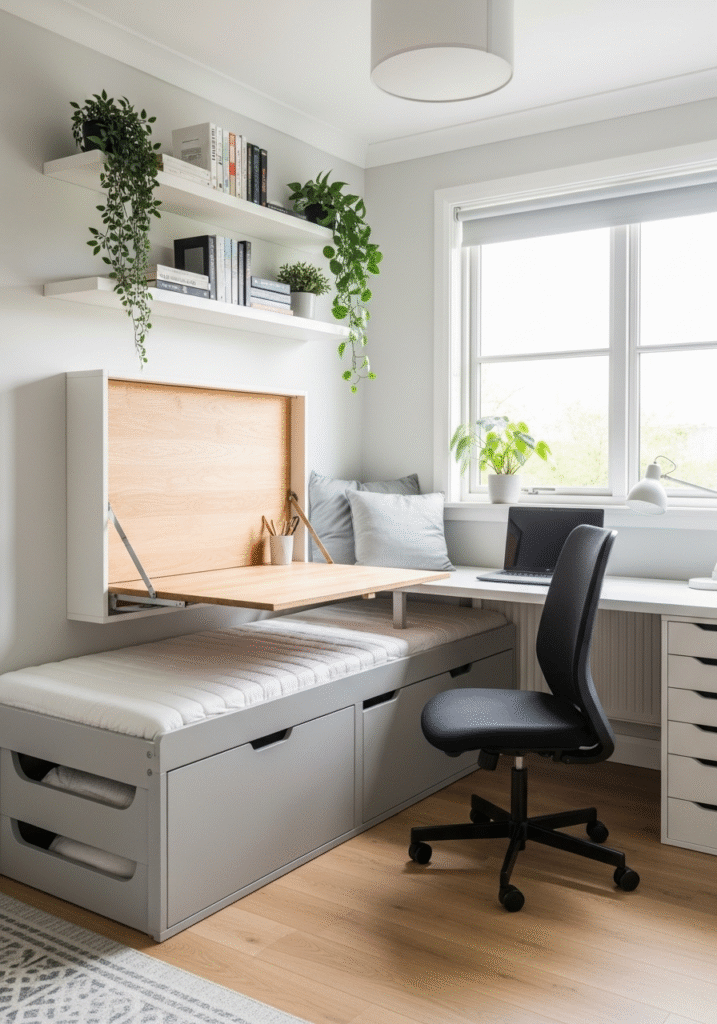Introduction
Are you struggling to make the most of a small room in your home? Whether it’s a tiny apartment, a compact bedroom, or a limited home office, creating a comfortable and organized space can be challenging. But with the right furniture hacks, small spaces can feel open, functional, and even luxurious. In this detailed blog, we explore Easy Furniture Hacks for Small Rooms that are budget-friendly, space-saving, and stylish—perfect for anyone looking to enhance their home without a complete renovation.
You’ll discover clever ways to use multi-purpose furniture, such as foldable desks, wall-mounted shelves, and storage ottomans that do double duty. Learn how to maximize vertical space, use under-bed storage, and choose furniture with built-in compartments to keep clutter out of sight. We also include DIY ideas for custom pieces, organization tips, and layout strategies that work even in the tightest corners.
Whether you’re living in a studio apartment or downsizing into a minimalist lifestyle, these practical hacks are designed to help you create a room that feels bigger and works smarter. From hidden storage tricks to convertible furniture that adapts to your needs, every tip in this blog is aimed at transforming your small room into a stylish, efficient living space.
Get ready to rethink your layout and upgrade your living experience with these simple yet powerful furniture hacks tailored for small spaces.
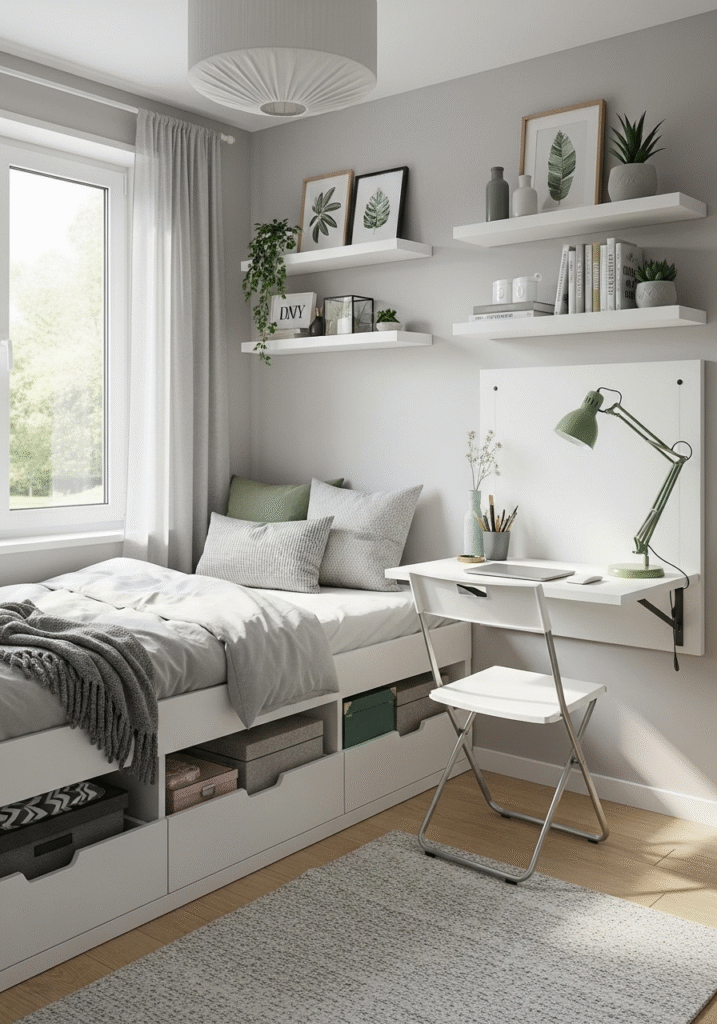
Why Furniture Hacks Matter in Small Rooms
In homes where space is limited, every inch becomes a valuable asset. Whether you’re living in a studio apartment, a cozy guest room, a student dorm, or a compact home office, designing with intention is essential. That’s where smart furniture hacks come in—they provide the perfect solution for making small rooms feel bigger, more functional, and far more stylish.
Traditional furniture pieces, while attractive, are often not designed with small spaces in mind. They can be bulky, heavy, and take up more room than they offer in utility. On the other hand, furniture hacks are about thinking creatively and strategically—using items that serve multiple purposes, add storage without clutter, and improve the overall flow of the room.
By incorporating space-saving furniture hacks, you can:
- Maximize floor space by using vertical areas for storage or wall-mounted fixtures.
- Integrate hidden storage through beds with drawers, ottomans with compartments, or fold-out desks.
- Create multi-functional zones, such as a dining table that doubles as a workspace or a sofa that turns into a guest bed.
- Improve traffic flow so the room feels more open and easier to navigate.
- Enhance visual openness using lightweight, minimalist, or transparent furniture that doesn’t overwhelm the space.
These hacks are not just practical—they’re also budget-friendly and easy to implement. With the right approach, you can transform even the smallest room into a cozy, efficient, and beautifully designed space that reflects your personality and meets your everyday needs.
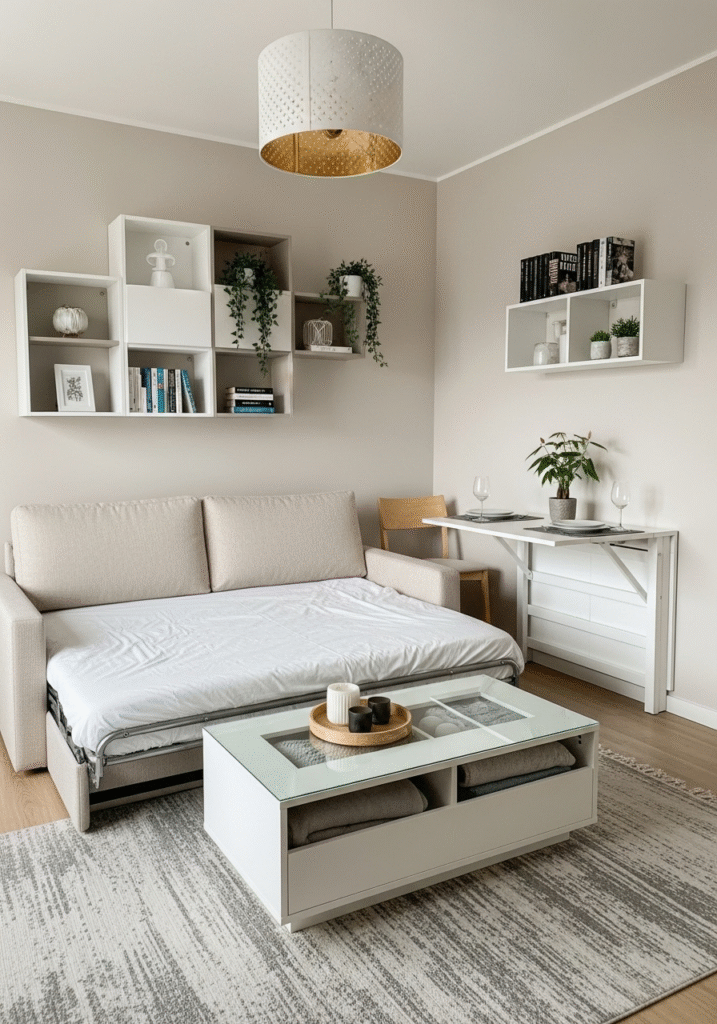
Top Easy Furniture Hacks for Small Spaces
Furnishing a small room doesn’t mean sacrificing functionality, comfort, or style. With the right furniture hacks, even the most compact space can be transformed into a versatile, organized, and aesthetically pleasing area. Whether you’re living in a studio apartment, outfitting a small bedroom, or optimizing a multifunctional guest room, these smart solutions can make a big impact. Here’s a comprehensive look at the top easy furniture hacks that are practical, affordable, and ideal for small living.
- Multi-functional Furniture
Choosing furniture that serves multiple purposes is key. Think sofa beds for overnight guests, ottomans with hidden storage, or coffee tables that double as desks. These pieces reduce clutter and make the most of your square footage. - Foldable and Collapsible Pieces
Furniture that folds, collapses, or expands when needed is perfect for tight spaces. Foldable chairs, drop-leaf tables, and extendable desks can be tucked away after use, freeing up valuable floor space. - Vertical Storage Solutions
Small rooms often lack surface space—so build up! Utilize tall bookshelves, wall-mounted crates, and cabinets above doorways to store essentials without consuming room on the floor. - Floating Furniture
Mounted desks, wall shelves, and floating nightstands offer surface space without bulk. This hack creates a modern look while opening up the floor for other uses. - Under-Bed Storage Ideas
Your bed can double as a hidden storage unit. Use rolling bins, built-in drawers, or repurposed dresser drawers on wheels to store clothes, linens, or off-season items efficiently. - Use Mirrors to Expand Visual Space
Mirrors reflect light and create the illusion of a larger room. Placing mirrors across from windows maximizes natural light and makes the space feel open and airy. - Compact Seating Arrangements
Swap out bulky sofas for loveseats, futons, or stackable stools. Floor seating and bean bags also offer flexible comfort without taking up unnecessary space. - Built-in Wall Desks or Drop-down Tables
For work-from-home setups or student study corners, a wall-mounted desk or fold-down table provides a functional workspace that tucks away when not in use. - Furniture with Hidden Storage
Opt for beds, benches, or ottomans that open up to reveal storage compartments. These pieces keep your room neat and clutter-free while offering practical solutions. - Corner Shelf & Furniture Use
Make use of every corner with L-shaped shelves, corner desks, or triangular storage units. These options help you utilize areas that would otherwise go unused.
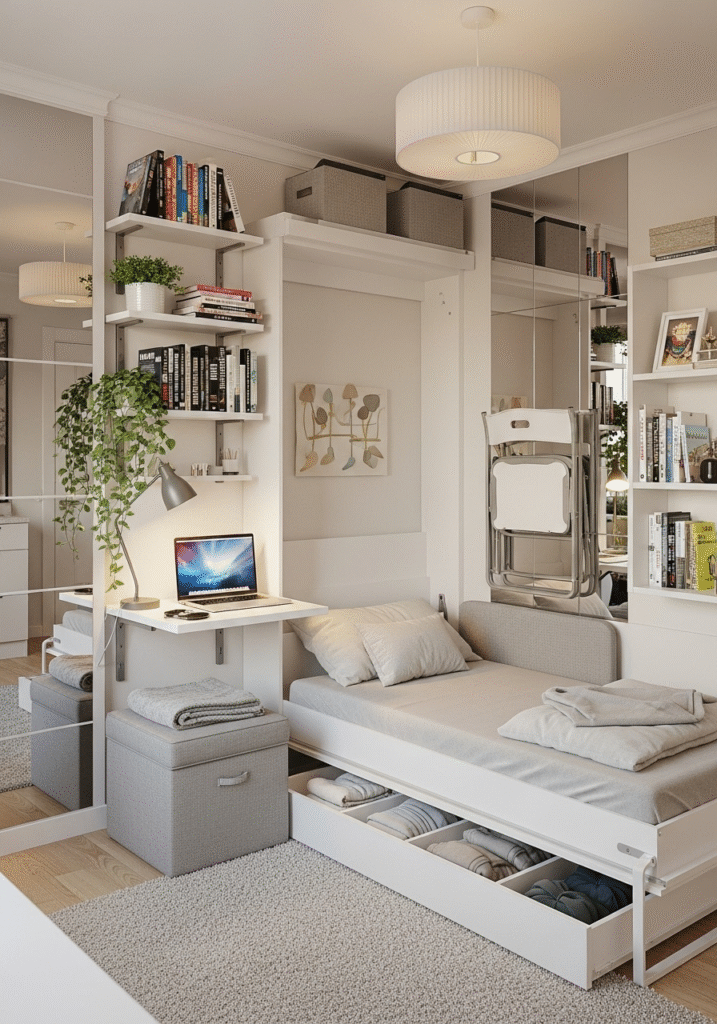
DIY Furniture Hacks You Can Try Today
You don’t need to hire a professional or spend hundreds of dollars to make your small space more functional and stylish. With a little creativity, some basic tools, and a DIY spirit, you can transform everyday items into practical, space-saving furniture that perfectly suits your needs. These DIY furniture hacks are beginner-friendly, budget-conscious, and ideal for maximizing small rooms without sacrificing style.
- DIY Pallet Bed with Storage
Turn reclaimed wooden pallets into a functional platform bed with built-in storage compartments underneath. Stack and secure the pallets to create a sturdy frame, leaving gaps for drawers, baskets, or crates. It’s not only affordable but also adds a rustic, industrial vibe to your room. - Floating Shelf Desk
A heavy-duty shelf with strong brackets can be converted into a minimalist desk for work or study. Mount it at the desired height and pair it with a compact chair or stool. This DIY project is perfect for small bedrooms, home offices, or unused wall space. - Rolling Kitchen Cart
Need more prep space in your kitchen? Build a simple, movable kitchen cart using wood, wheels, and a couple of shelves. It can act as a portable island, coffee station, or storage unit—great for studio apartments or tiny kitchens. - Crate Bookshelves
Stack and secure wooden crates vertically or side-by-side to create custom bookshelves, a bedside table, or even a TV stand. Paint or stain them to match your decor for a personalized and eco-friendly solution. - Pegboard Storage Wall
Pegboards are incredibly versatile and easy to install. Use them in the kitchen for utensils, in the craft room for tools, or near your entryway for keys and accessories. You can rearrange hooks and baskets anytime for customizable organization.
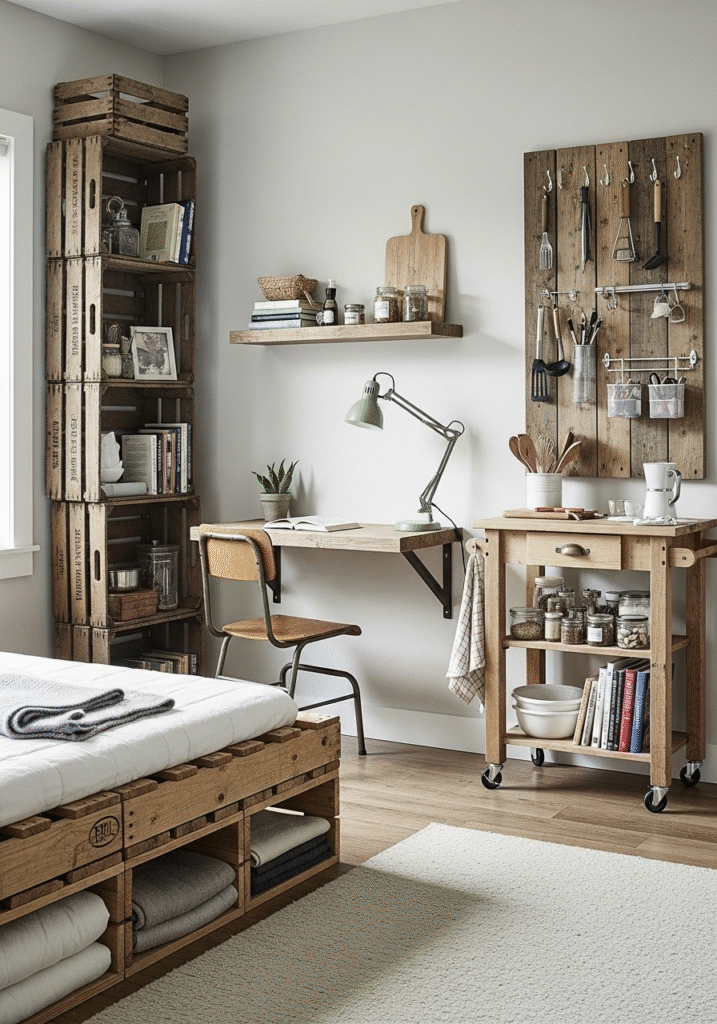
Smart Arrangement Tips for Small Spaces
When it comes to maximizing small spaces, the arrangement of your furniture is just as important as the furniture itself. Even the most space-saving pieces can feel bulky or ineffective if they’re placed without a thoughtful layout. The right arrangement can visually expand your room, improve functionality, and make your home feel more open and inviting.
Here are some smart and simple furniture arrangement tips that can transform the way you live in a small room:
- Keep Larger Furniture Against the Walls
Place beds, sofas, desks, and other large furniture pieces flush against the walls. This helps open up the central floor space, allowing for smoother movement and a more spacious feel. It also improves traffic flow and keeps your layout organized. - Avoid Blocking Windows
Natural light plays a critical role in making small rooms feel larger. Avoid placing tall or bulky furniture in front of windows. Let light flood in freely to brighten the room and give it a more airy and open atmosphere. - Create Functional Zones
Divide your room into different areas based on activity. Use rugs, lighting, or furniture placement to define spaces such as a reading nook, home office, sleeping zone, or entertainment area. This zoning technique adds order and purpose to even the smallest layouts. - Leave Breathing Room
Overcrowding a space with furniture can make it feel cramped and cluttered. Leave a few inches of space between pieces—like between your sofa and side table—to create visual “breathing room.” This small detail makes the room look more balanced and easier to navigate. - Use Rugs to Define Spaces
Area rugs can act as visual dividers in open or studio-style layouts. For example, place a rug under the bed to anchor your sleeping area, or under a small dining set to distinguish it from the living area. This tip not only adds warmth and texture but also helps define functional spaces without physical dividers.
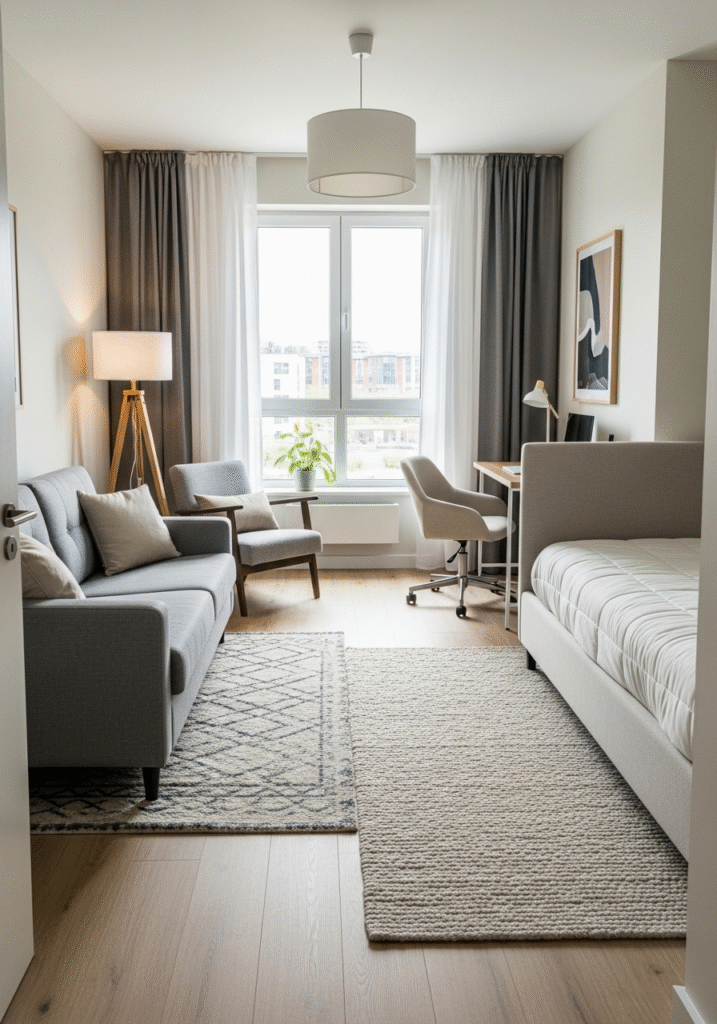
Common Mistakes to Avoid
Designing and furnishing a small space can be rewarding, but it also comes with its own unique set of challenges. While trying to create a functional and stylish layout, it’s easy to make mistakes that actually shrink the room visually or reduce its usability. Knowing what not to do is just as important as knowing the right hacks. Below are some of the most common mistakes to avoid when furnishing or decorating a small space—and what to do instead.
- Choosing Oversized Furniture
Large sofas, bulky wardrobes, and oversized coffee tables may look great in a showroom, but they can easily overwhelm a small room. They take up too much floor space and make the room feel cramped. Instead, opt for compact, streamlined pieces designed specifically for small-space living, such as armless chairs, nesting tables, or wall-mounted units. - Overloading with Décor
Too many decorative items on walls, shelves, and countertops can make a small room feel cluttered and chaotic. In small spaces, minimalism is key. Use a few statement pieces to add character without overwhelming the space. Think in terms of clean lines, simple color palettes, and intentional decoration. - Ignoring Vertical Space
Many people forget to use the vertical space available. Walls offer an excellent opportunity for storage and design. Utilize tall bookshelves, hanging organizers, floating shelves, and wall hooks to store items and free up floor space. This not only adds functionality but also draws the eye upward, making the room feel taller. - Neglecting Lighting
Poor lighting can make a small space feel dark and boxed in. Don’t rely solely on a single overhead light. Layer your lighting with floor lamps, wall sconces, string lights, or under-shelf LEDs to brighten every corner and create depth and warmth in the room. - Using Too Many Dark Colors
While dark tones can be stylish, overusing them in a small room can make the space feel closed in. Lighter shades like whites, soft grays, pastels, or neutrals reflect more light and make the room appear more spacious and open. If you love darker hues, consider using them as accents rather than dominant colors.
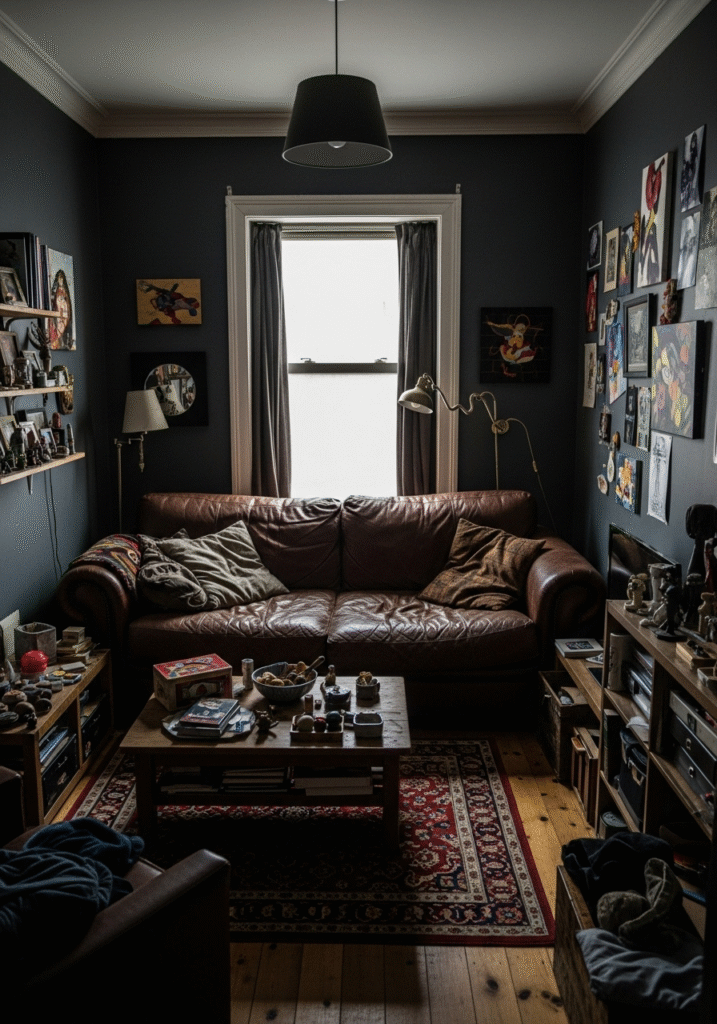
Benefits of Optimized Small Room Design
When you embrace an optimized small‑room design, you’re doing much more than making a space look pretty—you’re creating a living environment that works smarter, feels calmer, and costs less to maintain. By integrating space‑saving furniture hacks, smart layouts, and minimalist principles, you unlock a range of advantages that can dramatically elevate your day‑to‑day life.
- Improved Functionality
In a well‑planned room, every piece of furniture serves a clear purpose—and often more than one. A lift‑top coffee table becomes a dinner tray; a wall‑mounted desk doubles as a vanity. This purposeful approach turns limited square footage into a multifunctional hub where work, relaxation, and storage coexist seamlessly. - Less Clutter, More Calm
Hidden compartments, under‑bed drawers, and vertical shelving keep belongings neatly tucked away, reducing visual noise and mental stress. A clutter‑free environment promotes better focus and fosters a sense of calm, making your small space feel like a personal sanctuary rather than a cramped catch‑all. - Greater Freedom of Movement
Strategic layouts widen walking paths and eliminate unnecessary obstacles. By positioning bulkier items against walls, keeping corners clear, and using floating or foldable pieces, you create open floor space that makes daily activities—getting dressed, stretching, or hosting friends—far more comfortable. - Cost‑Effectiveness
Because multi‑use furniture covers multiple needs, you buy fewer items overall. Modular or convertible pieces cost more upfront but save money in the long run by replacing two or three single‑use furnishings. Plus, DIY hacks such as pallet beds or crate shelves let you upgrade without overspending. - Stylish, Modern Appeal
Optimized small‑room design naturally trends toward a minimalist, contemporary aesthetic. Clean lines, airy color palettes, and intentional décor keep the space looking fresh and on trend. When guests walk in, they see thoughtful design choices—proof that “small” can still be chic, cozy, and Instagram‑worthy.
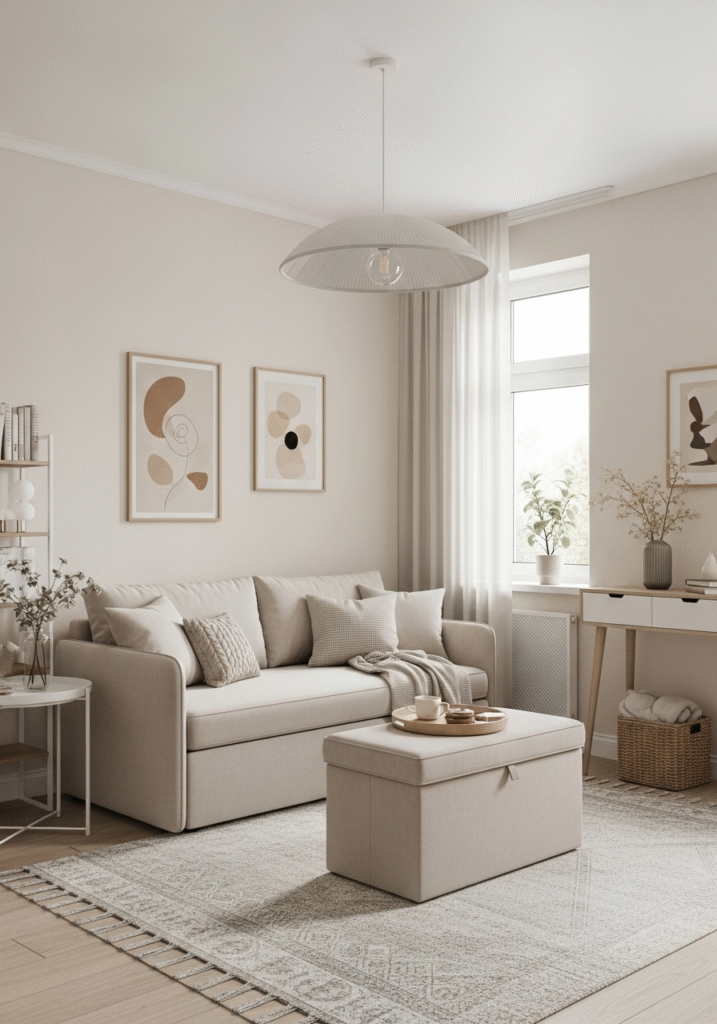
Living in a small space doesn’t mean you have to compromise on comfort, beauty, or practicality. With the right approach and smart furniture hacks, even the tiniest room can be transformed into a stylish, well-organized, and fully functional living area. Whether you’re downsizing, renting a compact apartment, or simply trying to make the most of an underutilized room, small spaces offer a unique opportunity to get creative and intentional with design.
Throughout this guide, we’ve explored a variety of easy and effective furniture hacks—from multi-functional and foldable pieces to vertical storage solutions and DIY projects. These ideas are not only budget-friendly but also tailored to help you optimize space without sacrificing style. Smart arrangements, hidden storage, and light-enhancing tricks like mirrors can make a huge visual impact, while minimalism keeps your room feeling open and inviting.
More importantly, these solutions support better day-to-day living. When your room is thoughtfully arranged and each item serves a purpose, you enjoy more clarity, better movement, and less stress. Your space becomes more than just a place to live—it becomes a personalized sanctuary that reflects your taste and meets your everyday needs.
So, whether you’re updating your small bedroom, organizing a compact kitchen, or creating a cozy nook for work or relaxation, remember:
It’s not about how much space you have—it’s about how you use it.
With the right furniture hacks and a little creativity, you can achieve big style in even the smallest spaces—and love every square inch of your home.
